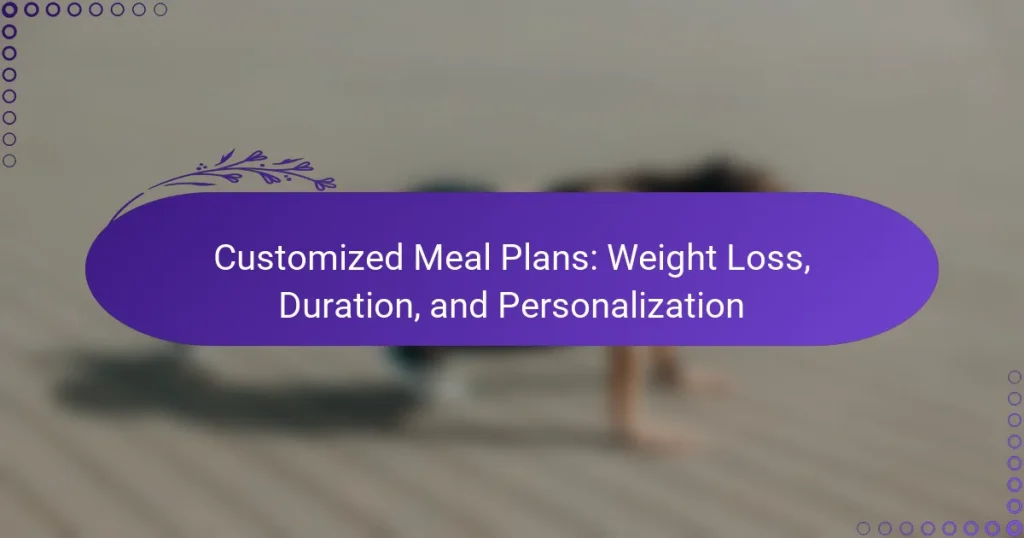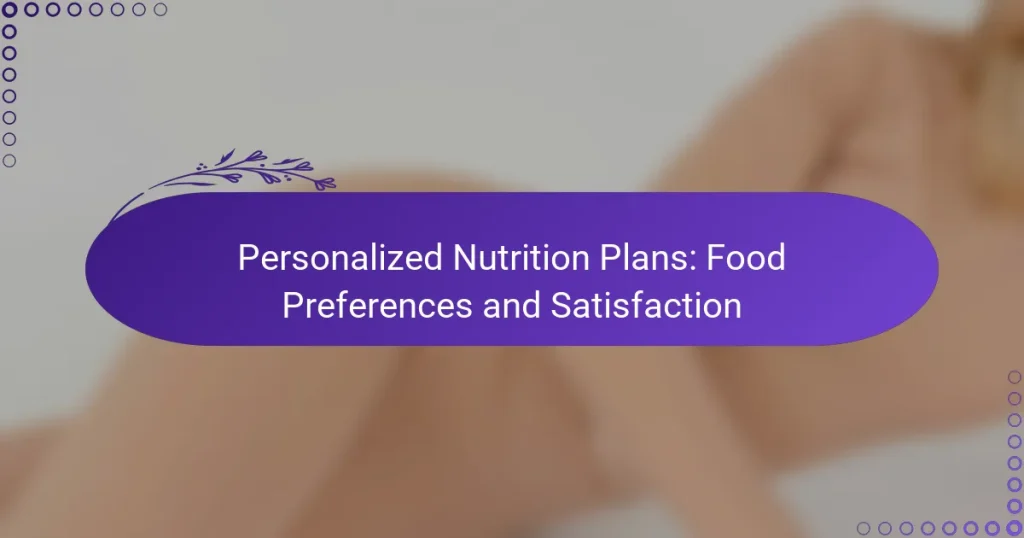Mindful nutrition and personalized meal planning are essential for achieving optimal health and fitness. By catering to individual dietary needs and preferences, these plans promote awareness of food choices and their impact on overall well-being. Tailored meal suggestions and nutritional guidance empower individuals to make healthier decisions that align with their fitness goals.
Meal Planning Tools: Comparison, Efficiency, and Usability
Nutrition Apps: Personalization, Tracking, and Results
Customized Meal Plans: Weight Loss, Duration, and Personalization
Tailored Meal Plans: Vegan Benefits and Nutritional Balance
Macronutrient Ratios: Customization, Balance, and Health
Personalized Nutrition Plans: Food Preferences and Satisfaction
What are the best personalized meal planning services in the US?
The best personalized meal planning services in the US cater to individual dietary needs, preferences, and goals. These services typically offer tailored meal suggestions, grocery lists, and nutritional guidance to help users maintain a balanced diet.
MyFitnessPal
MyFitnessPal is a comprehensive app that combines meal planning with calorie tracking. Users can log their meals, track their macronutrients, and receive personalized meal suggestions based on their dietary goals. The app also has a vast database of foods, making it easy to find and log meals.
One of the key features is its community aspect, where users can connect with others for support and motivation. However, relying solely on user-generated data can sometimes lead to inaccuracies in nutritional information.
Eat This Much
Eat This Much focuses on automating meal planning based on user preferences and dietary restrictions. Users input their goals, and the service generates a weekly meal plan complete with recipes and grocery lists. This can save time and reduce the stress of planning meals.
It’s particularly useful for those with specific dietary needs, such as vegan or gluten-free diets. However, users should review the generated plans to ensure they align with personal tastes and nutritional requirements.
PlateJoy
PlateJoy offers personalized meal plans that adapt to individual health goals, family size, and food preferences. After completing a detailed questionnaire, users receive customized recipes and shopping lists tailored to their lifestyle. This service emphasizes fresh ingredients and seasonal recipes.
PlateJoy also integrates with grocery delivery services, making it convenient for users to receive their ingredients. However, the subscription cost may be higher than some other meal planning services, so users should weigh the benefits against their budget.
How can mindful nutrition improve fitness outcomes?
Mindful nutrition enhances fitness outcomes by promoting awareness of food choices and their effects on the body. This approach encourages individuals to make healthier eating decisions that align with their fitness goals, leading to better energy levels and effective weight management.
Enhances energy levels
Mindful nutrition helps boost energy levels by focusing on nutrient-dense foods that provide sustained energy. Incorporating whole grains, lean proteins, and healthy fats can prevent energy crashes often associated with processed foods and sugary snacks.
To maintain high energy throughout the day, aim for balanced meals that include a mix of macronutrients. For example, a meal with quinoa, grilled chicken, and avocado can offer a steady release of energy, keeping you active and alert.
Supports weight management
Mindful nutrition plays a crucial role in weight management by encouraging portion control and conscious eating habits. By paying attention to hunger cues and eating slowly, individuals are less likely to overeat and more likely to enjoy their meals.
To effectively manage weight, consider keeping a food journal to track what you eat and how it makes you feel. This practice can help identify patterns and areas for improvement, allowing for adjustments that align with your fitness objectives.
What factors to consider when creating a personalized meal plan?
When creating a personalized meal plan, consider dietary preferences, nutritional goals, and activity level. These factors help tailor a plan that meets individual needs and supports overall health and fitness.
Dietary preferences
Dietary preferences include personal likes and dislikes, cultural influences, and any specific dietary restrictions. For example, some individuals may follow vegetarian, vegan, or gluten-free diets, which require careful selection of food sources to ensure balanced nutrition.
Understanding these preferences is crucial for adherence to the meal plan. A plan that aligns with personal tastes is more likely to be followed consistently, leading to better health outcomes.
Nutritional goals
Nutritional goals can vary widely, from weight loss and muscle gain to improved energy levels or managing health conditions. Setting clear, achievable goals helps in selecting the right foods and portion sizes.
For instance, someone aiming to lose weight might focus on a calorie deficit, while an athlete may prioritize protein intake for muscle recovery. Regularly reviewing and adjusting these goals ensures the meal plan remains effective.
Activity level
Activity level significantly influences dietary needs. Individuals with a sedentary lifestyle typically require fewer calories than those who are highly active. It’s essential to match food intake with energy expenditure to maintain a healthy weight.
For example, a moderately active person might need around 2,000 to 2,500 calories per day, while an athlete could require 3,000 calories or more, depending on their training intensity. Tailoring the meal plan to activity level ensures optimal performance and recovery.
How to integrate fitness plans with meal planning?
Integrating fitness plans with meal planning involves aligning your workout schedule with your nutritional intake to optimize performance and recovery. This approach ensures that your body receives the right nutrients at the right times, enhancing energy levels and overall results.
Schedule workouts around meals
To effectively schedule workouts around meals, consider timing your exercise sessions to coincide with your meal intake. Aim to work out 1-2 hours after a balanced meal to ensure your body has enough fuel, or plan a workout before a meal to stimulate appetite and enhance nutrient absorption post-exercise.
For example, if you typically have lunch at noon, consider scheduling your workout for around 1 PM. This allows your body to digest and utilize the nutrients from lunch, providing you with the energy needed for your workout.
Choose nutrient-dense pre- and post-workout meals
Selecting nutrient-dense meals before and after workouts is crucial for optimal performance and recovery. Pre-workout meals should include a balance of carbohydrates and protein, such as a banana with peanut butter or Greek yogurt with berries, to provide sustained energy.
Post-workout, focus on replenishing glycogen stores and repairing muscles with meals rich in protein and carbohydrates. Options like a protein shake with a piece of fruit or grilled chicken with quinoa and vegetables can effectively support recovery. Aim to eat within 30-60 minutes after exercising for the best results.
What are the costs associated with personalized meal planning?
The costs of personalized meal planning can vary significantly based on the services chosen and individual dietary needs. Generally, expenses can be categorized into subscription fees for meal planning services and grocery costs for the ingredients needed.
Subscription fees
Subscription fees for personalized meal planning services typically range from around $10 to $50 per month. These fees often cover access to customized meal plans, recipes, and sometimes additional resources like nutrition coaching or community support.
When selecting a service, consider what features are included in the subscription. Some platforms may offer more comprehensive tools, such as calorie tracking or integration with fitness apps, which could justify higher costs.
Grocery costs
Grocery costs for personalized meal planning can vary widely depending on dietary preferences and local prices. On average, individuals might spend between $50 to $150 per week on groceries, influenced by factors like organic versus non-organic choices and the inclusion of specialty items.
To manage grocery expenses effectively, create a shopping list based on your meal plan and stick to it. Look for sales, use coupons, and consider buying in bulk for frequently used items to reduce overall costs.
How to choose the right meal planning app?
To choose the right meal planning app, consider your specific dietary needs, ease of use, and features that align with your lifestyle. Look for apps that offer personalized meal suggestions, grocery lists, and nutritional tracking to enhance your meal planning experience.
User interface and experience
The user interface (UI) and overall experience of a meal planning app are crucial for effective use. A clean, intuitive layout allows for quick navigation and reduces frustration. Look for apps that provide easy access to recipes, meal schedules, and shopping lists without overwhelming clutter.
Consider apps that offer visual elements, such as photos of meals or a calendar view for meal planning. These features can enhance usability and make the meal planning process more enjoyable. Reading user reviews can also provide insights into the app’s overall experience.
Customization options
Customization options are essential for tailoring meal plans to fit individual dietary preferences and restrictions. Look for apps that allow you to input specific dietary goals, such as calorie limits or macronutrient ratios, and offer recipes that align with these parameters.
Additionally, consider whether the app provides options for adjusting portion sizes, swapping ingredients, or creating shopping lists based on your selected meals. This flexibility can help you maintain a balanced diet while accommodating personal tastes and nutritional needs.





